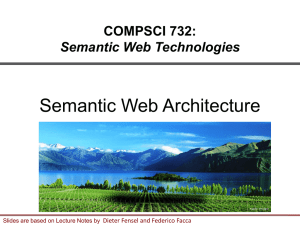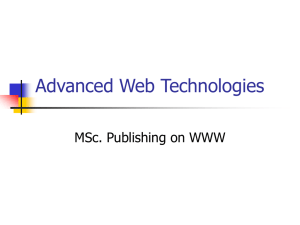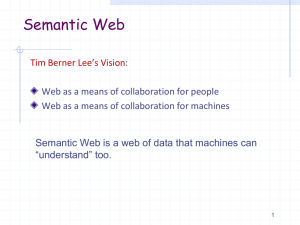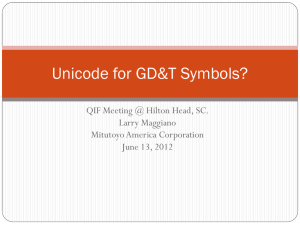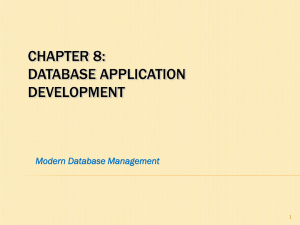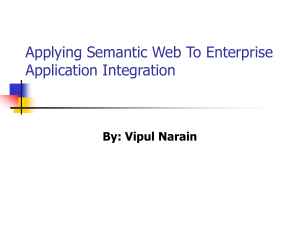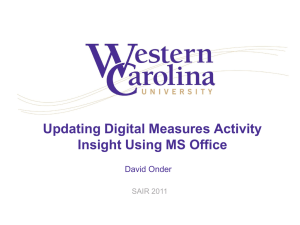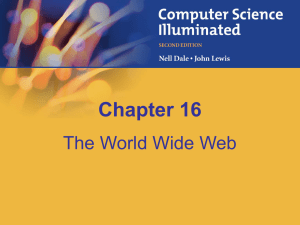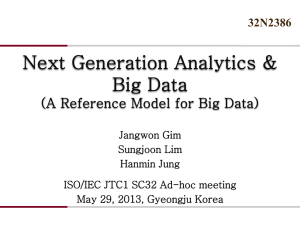Semantic Web Architecture - Teaching-WIKI
advertisement
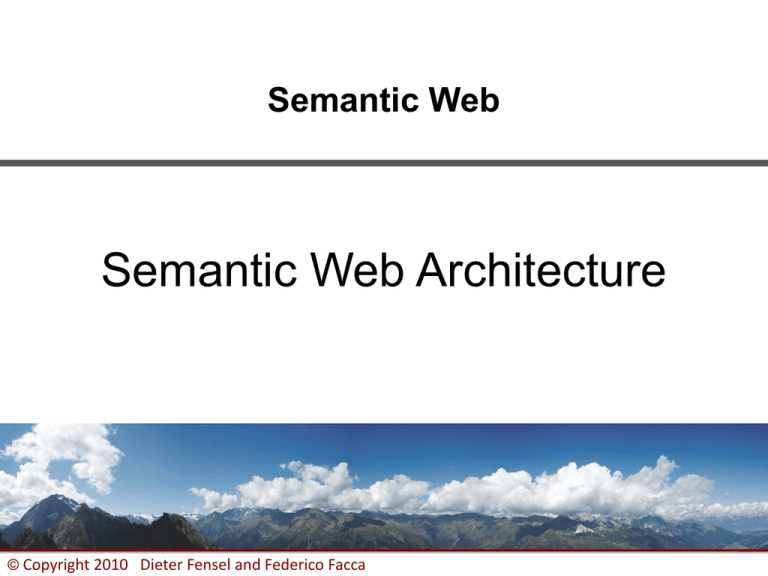
Semantic Web
Semantic Web Architecture
© Copyright 2010 Dieter Fensel and Federico Facca
1
Where are we?
#
Title
1
Introduction
2
Semantic Web Architecture
3
Resource Description Framework (RDF)
4
Web of data
5
Generating Semantic Annotations
6
Storage and Querying
7
Web Ontology Language (OWL)
8
Rule Interchange Format (RIF)
9
Reasoning on the Web
10
Ontologies
11
Social Semantic Web
12
Semantic Web Services
13
Tools
14
Applications
2
Overview
•
•
Introduction and motivation
Technical solutions
–
–
–
–
–
•
•
•
•
Semantic Web architecture
Uniform Resource Identifier
Extensible Markup Language
XML Schema
Namespaces
Extensions
Illustration by a large example
Summary
References
3
INTRODUCTION AND
MOTIVATION
4
Web Architecture
•
•
The Semantic Web extends the Web
Web architecture principles
– Simplicity
– Orthogonality of specifications
•
•
Identification vs. interaction vs. representation
Better manageability, independent evolution
– Extensibility
•
•
Extending and subsetting
Web of documents
– Wealth of data
– Mostly in HTML, XML – data islands
5
Semantic Web
•
Semantic data
– Powerful queries, inference, reasoning
•
Linked data
– Data integration and reuse
– Combining data from differen sources
•
Semantic automation
– Mediation of different vocabularies
– Data mining
– Automated use of Web services
6
Semantic Web Architecture
•
Formalized components and their relationships
– What technologies make up Semantic Web
– What are the dependencies between components
•
Roadmap for steps of developing the Semantic Web
7
The Semantic Web architecture and its foundations
TECHNICAL SOLUTION
8
Search and Query the Web I
•
The Web is a constantly growing network of distributed resources
–
–
–
–
•
More than 1 trillion unique URLs
More than 100 billion pages
More than 200 million web sites
Check most updated data on:
http://news.netcraft.com/archives/web_server_survey.html
User needs to be able to efficiently search resources/content over the
Web
– When I Google “Milan” do I find info on the city or the soccer team?
•
User needs to be able to perform query over largely distributed
resources
– When is the next performance of the rock band “U2”, where it will be located, what are
the best way to reach the location, what are the attractions nearby…
9
Search and Query the Web II
•
On2Broker is the evolution of Ontobroker, a systems that aims at
providing a solution to the problems discussed in the previous slides by
adopting Semantic Technologies
•
On2Broker is a system that processes distributed information sources
and that provides intelligent information retrieval, query answering
•
On2Broker relies on components of the Semantic Web Architecture:
analysis of such systems driven the definition of the Semantic Web
Architecture
[D. Fensel, S. Decker, M. Erdmann, R. Studer: Ontobroker in a Nutshell. ECDL 1998: 663664]
10
On2Broker: Architecture
[Adapted from Fensel et al., On2broker: Semantic-Based
Access to Information Sources at the WWW]
11
On2Broker Components I
•
Query Interface
– Provides a structured input structure that enable users to define their queries without
any knowledge of the query language
– Input queries are then transformed to the query language (e.g. SparQL)
•
Repository
– Decouples query answering, information retrieval and reasoning
– Provide support for materialization of inferred knowledge
12
On2Broker Components II
•
Crawlers and Wrappers (or Info Agent)
– Extract knowledge from different distributed and heterogeneous data sources
– RDF-A pages and RDF repositories can be included directly
– HTML and XML data sources requires processing provided by wrappers to derive RDF
data
•
Inference Engine
– Relies on knowledge imported from the crawlers and axioms contained in the
repository to support query answers
– Adopts horn-logic and closed world assumption
13
On2Broker: Example
5.
1. Who is known by Dieter
Fensel?
John Domingues and
Frank van Harmelen
are known by Dieter
Fensel
2. SELECT DISTINCT ?s ?o
WHERE { ?s foaf:knows
?o . } …
3.
4.
Extends KB:
if “x dblp:coauthor y“
then “x foaf:knows y”
if “y foaf:knows x“ then
“x foaf:knows y”
Extract RDF from:
3. Extract RDF from:
fensel.com
fensel.com
dblp
dblp
…
…
14
SemWeb Architecture: Requirements
•
Extensibility
– Each layer should extend the previous one(s)
•
Support for data interchange
– Using data from one source in other applications
•
Support for ontology description with different complexity
– Including rules
•
•
Support for data query
Support for data provenance and trust evaluation
see the Semantic Web Roadmap: http://www.w3.org/DesignIssues/Semantic.html
15
Semantic Web Stack
Adapted from http://en.wikipedia.org/wiki/Semantic_Web_Stack
Rules:
RIF
16
UNICODE, URI and XML
•
UNICODE is the standard international character set
– E.g. used to encode the data in the repository
•
Uniform Resource Identifiers (URIs) identify things and concepts
– E.g. used to indentify resources on the Web and in the repository
•
eXtensible Markup Language (XML) is a markup language used for
data exchange
– E.g. format that can be wrapped into RDF and imported into the repository
17
RDF, RDFS and OWL
• Resource Description Framework (RDF) is
the HTML of the Semantic Web
–
–
–
–
–
–
Simple way to describe resources on the Web
Based on triples <subject, predicate, object>
Various serializations, including one based on XML
A simple ontology language (RDFS)
E.g. language used to store the data in the repository
More in Lecture 3
• Web Ontology Language (OWL) is
a more complex ontology language than RDFS
– Layered language based on DL
– Overcomes some RDF(S) limitations
– E.g. ontology language used to define the schemas used in the
repository
– More in Lecture 7
18
SPARQL and Rule Languages
•
SPARQL
–
–
–
–
•
Query language for RDF triples
A protocol for querying RDF data over the Web
E.g. language used to query the repository from the user interface
More in lecture 6
Rule languages (esp. Rule Interchange Format RIF)
– Extend ontology languages with proprietary axioms
– Based on different types of logics
•
•
Description Logic
Logic Programming
– E.g. used to enable reasoning over data to infer new knowledge
– More in lecture 8
19
Logics, Proof and Trust
•
Unifying logic
– Bring together the various ontology and rule languages
– Common inferences, meaning of data
•
Proof
– Explanation of inference results, data provenance
•
Trust
–
–
–
–
•
Trust that the system performs correctly
Trust that the system can explain what it is doing
Network of trust for data sources and services
Technology and user interface
Many open problems, topics for future research
20
Foundations
Rules:
RIF
21
More than a-z, A-Z
UNICODE
22
Character Sets
• ASCII – 7 bit, 128 characters (a-z, A-Z, 0-9, punctuation)
• Extension code pages – 128 chars (ß, Ä, ñ, ø, Š, etc.)
– Different systems, many different code pages
– ISO Latin 1, CP1252 – Western languages
– ISO Latin 2, CP1250 – East Europe
(197 = Å)
(197 = Ĺ)
• Code page is an interpretation, not a property of text
• Thus if we do not interpret correctly the code page, the
result visualized will not be the expected one
23
UNICODE: a unambiguous code
•
We need a solution that can be unambiguously interpreted, i.e. where
to a code correspond a single character and viceversa
•
That’s why UNICODE was created!
$Å Ĺ Æ
ή
U+0024
U+00C5
U+0139 U+00C6 U+03AE
♥ ⅝كЖญ
U+0643
U+215D U+2665 U+0416 U+0E0D
24
UNICODE
• ISO standard
– About 100'000 characters, space for 1'000'000
– Unique code points from U-0000 through U-FFFF to U-10FFFF
– Well-defined process for adding characters
• When dealing with any text, simply use UNICODE
– Character code charts: http://www.unicode.org/charts/
• See also:
– http://www.tbray.org/talks/rubyconf2006.pdf
– http://tbray.org/ongoing/When/200x/2003/04/06/Unicode
25
How to identify things on the Web
URI: UNIFORM
RESOURCE IDENTIFIERS
26
Identifier, Resource, Representation
Taken from http://www.w3.org/TR/webarch/
27
URI, URN, URL
•
A Uniform Resource Identifier (URI) is a string of characters used to identify
a name or a resource on the Internet
•
•
A URI can be a URL or a URN
A Uniform Resource Name (URN) defines an item's identity
–
•
the URN urn:isbn:0-395-36341-1 is a URI that specifies the identifier system, i.e.
International Standard Book Number (ISBN), as well as the unique reference within that
system and allows one to talk about a book, but doesn't suggest where and how to obtain an
actual copy of it
A Uniform Resource Locator (URL) provides a method for finding it
–
the URL http://www.sti-innsbruck.at/ identifies a resource (STI's home page) and implies that
a representation of that resource (such as the home page's current HTML code, as encoded
characters) is obtainable via HTTP from a network host named www.sti-innsbruck.at
28
URI Syntax
•
Examples
–
–
–
–
•
http://www.ietf.org/rfc/rfc3986.txt
mailto:John.Doe@example.com
news:comp.infosystems.www.servers.unix
telnet://melvyl.ucop.edu/
URI Syntax
–
–
–
–
–
scheme: [//authority] [/path] [?query] [#fragid]
The scheme distinguishes different kinds of URIs
Authority normally identifies a server
Path normally identifies a directory and a file
Query adds extra parameters
Fragment ID identifies a secondary resource
29
URI Syntax cont’d
•
•
•
Reserved characters (like /:?#@$&+* )
Many allowed characters
Rest percent-encoded from UTF-8
– http://google.com/search?q=technikerstra%C3%9Fe
•
IRI – Internationalized Resource Identifier
– Allows whole UNICODE
– Specifies transformation into URI – mostly UTF-8 encoding
30
URI Schemes
Scheme Description
• Schemes partition
the URI space
into subspaces
• Schemes can add
or clarify properties
of resources
– Ownership
(how authorities
are formed)
– Persistence
(how stable
the URIs should be)
– Protocol
(default access protocol)
RFC
file
Host-specific file names
[1738]
ftp
File Transfer Protocol
[1738]
http
Hypertext Transfer Protocol
[2616]
https
Hypertext Transfer Protocol Secure
[2818]
Instant Messaging
[3860]
internet message access protocol
[5092]
ipp
Internet Printing Protocol
[3510]
iris
Internet Registry Information Service
[3981]
ldap
Lightweight Directory Access Protocol
[4516]
Electronic mail address
[2368]
message identifier
[2392]
im
imap
mailto
mid
From http://www.iana.org/assignments/uri-schemes.html
31
How to exchange structured data on the Web
XML: EXTENSIBLE
MARKUP LANGUAGE
32
eXtensible Markup Language
• Language for creating languages
– “Meta-language”
– XHTML is a language: HTML expressed in XML
• W3C Recommendation (standard)
– XML is, for the information industry,
what the container is for international shipping
– For structured and semistructured data
• Main plus: wide support, interoperability
– Platform-independent
• Applying new tools to old data
33
Structure of XML Documents
• Elements, attributes, content
• One root element in document
• Characters, child elements in content
34
XML Element
• Syntax <name>contents</name>
– <name> is called the opening tag
– </name> is called the closing tag
• Examples
<gender>Female</gender>
<story>Once upon a time there was…. </story>
• Element names case-sensitive
35
Attributes to XML Elements
• Name/value pairs, part of element contents
• Syntax
<name attribute_name="attribute_value">contents</name>
• Values surrounded by single or double quotes
• Example
<temperature unit="F">64</temperature>
<swearword language='fr'>con</swearword>
36
Empty Elements
• Empty element: <name></name>
• This can be shortened: <name/>
• Empty elements may have attributes
• Example
<grade value='A'/>
37
Comments
• May occur anywhere in element contents or outside the
root element
• Start with <!-• End with -->
• May not contain a double hyphen
• Comments cannot be nested
• Example:
<element>content
<!-- a comment, will be ignored in processing -->
</element>
<!-- comment outside the root element -->
38
Nesting Elements
• Elements may contain other (child) elements
– The containing element is the parent element
• Elements must be properly nested
• Example with improper nesting:
<b>bold <i>bold-italic</b> italic?</i>
• The above is not XML (not well-formed)
39
Special Characters in XML
• < and > are obviously reserved in content
– Written as &lt; and &gt;
• Same for ' and " in attribute values
– Written as &apos; and &quot;
• Now & is also reserved
– Written as &amp;
• Any character: &#223; or &#xdf;
ß
– Decimal or hexa-decimal unicode code point
• Elements and attributes whose name starts with “xml”
are also special
40
Uses of XML
• Document mark-up – XHTML
– HTML is a language, so it can be expressed in XML
• Exchanged data
–
–
–
–
Scalable vector graphics – SVG
E-commerce – ebXML
Messaging in general – SOAP
And many more standards
• Internal data
– Databases
– Configuration files
• Etc.
41
Why XML?
• For semistructured data:
– Loose but constrained structure
– Unspecified content length
• For structured data:
–
–
–
–
Table(s) or similar rows
Well-defined structure, data types
Good interoperability
But: requirements for quick access, processing
42
XML Parsers
• Document Object Model (DOM) builder
– Creates an object model of XML document
– In-memory representation, random access
– DOM complex, simpler JDOM etc.
• Simple API for XML parsing (SAX)
–
–
–
–
Views XML as stream of events
el_start("date"), attribute("day", "10"), el_end("date")
Calls your handler
DOM builder can use SAX
• Pull parsers
– You call source of XML events
43
How to distinguish categories of resources
NAMESPACES
44
The Problem
• Documents use different vocabularies
– Example 1: CD music collection
– Example 2: online order transaction
• Merging multiple documents together
– Name collisions can occur
• Example 1: albums have a <name>
• Example 2: customers have a <name>
– How do you differentiate between the two?
45
The Solution: Namespaces!
• What is a namespace?
– A syntactic way to differentiate similar names in an XML document
• Binding namespaces
– Uses Uniform Resource Identifier (URI)
• e.g. “http://example.com/NS”
– Can bind to a named or “default” prefix
46
Namespace Binding Syntax
• Use “xmlns” attribute
– Named prefix
• <a:foo xmlns:a=‘http://example.com/NS’/>
– Default prefix
• <foo xmlns=‘http://example.com/NS’/>
• Element and attribute names are “qualified”
– URI, local part (or “local name”) pair
• e.g. { “http://example.com/NS” , “foo” }
47
Example Document I
•
Namespace binding
<?xml version=‘1.0’ encoding=‘UTF-8’?>
<order>
<item code=‘BK123’>
<name>Care and Feeding of Wombats</name>
<desc xmlns:html=‘http://www.w3.org/1999/xhtml’>
The <html:b>best</html:b> book ever written!
</desc>
</item>
</order>
48
Example Document II
•
Namespace scope
<?xml version=‘1.0’ encoding=‘UTF-8’?>
<order>
<item code=‘BK123’>
<name>Care and Feeding of Wombats</name>
<desc xmlns:html=‘http://www.w3.org/1999/xhtml’>
The <html:b>best</html:b> book ever written!
</desc>
</item>
</order>
49
Example Document III
•
Bound elements
<?xml version=‘1.0’ encoding=‘UTF-8’?>
<order>
<item code=‘BK123’>
<name>Care and Feeding of Wombats</name>
<desc xmlns:html=‘http://www.w3.org/1999/xhtml’>
The <html:b>best</html:b> book ever written!
</desc>
</item>
</order>
50
How to define XML document structures
XML SCHEMA
51
What is it?
• A grammar definition language
– Like DTDs but better
• Uses XML syntax
– Defined by W3C
• Primary features
– Datatypes
• e.g. integer, float, date, etc…
– More powerful content models
• e.g. namespace-aware, type derivation, etc…
52
XML Schema Types
• Simple types
– Basic datatypes
– Can be used for attributes and element text
– Extendable
• Complex types
– Defines structure of elements
– Extendable
• Types can be named or “anonymous”
53
Simple Types
• DTD datatypes
– Strings, ID/IDREF, NMTOKEN, etc…
• Numbers
– Integer, long, float, double, etc…
• Other
– Binary (base64, hex)
– QName, URI, date/time
– etc…
54
Deriving Simple Types
• Apply facets
– Specify enumerated values
– Add restrictions to data
– Restrict lexical space
• Allowed length, pattern, etc…
– Restrict value space
• Minimum/maximum values, etc…
• Extend by list or union
55
A Simple Type Example
• Integer with value (1234, 5678]
<xsd:simpleType name=‘MyInteger’>
<xsd:restriction base=‘xsd:integer’>
<xsd:minExclusive value=‘1234’/>
<xsd:maxInclusive value=‘5678’/>
</xsd:restriction>
</xsd:simpleType>
56
A Simple Type Example II
• Validating integer with value (1234, 5678]
<data xsi:type='MyInteger'></data>
<data xsi:type='MyInteger'>Andy</data>
<data xsi:type='MyInteger'>-32</data>
<data xsi:type='MyInteger'>1233</data>
<data xsi:type='MyInteger'>1234</data>
<data xsi:type='MyInteger'>1235</data>
<data xsi:type='MyInteger'>5678</data>
<data xsi:type='MyInteger'>5679</data>
INVALID
INVALID
INVALID
INVALID
INVALID
INVALID
57
Complex Types
• Element content models
– Simple
– Mixed
• Unlike DTDs, elements in mixed content can be ordered
– Sequences and choices
• Can contain nested sequences and choices
– All
• All elements required but order is not important
58
A Complex Type Example I
• Mixed content that allows <b>, <i>, and <u>
<xsd:complexType name=‘RichText’ mixed=‘true’>
<xsd:choice minOccurs=‘0’ maxOccurs=‘unbounded’>
<xsd:element name=‘b’ type=‘RichText’/>
<xsd:element name=‘i’ type=‘RichText’/>
<xsd:element name=‘u’ type=‘RichText’/>
</xsd:choice>
</xsd:complexType>
59
A Complex Type Example II
• Validation of RichText
<content xsi:type='RichText'></content>
<content xsi:type='RichText'>Andy</content>
<content xsi:type='RichText'>XML is
<i>awesome</i>.</content>
<content
xsi:type='RichText'><B>bold</B></content>
INVALID
<content xsi:type='RichText'><foo/></content>
INVALID
60
How to distinguish categories of resources
NAMESPACES
61
The Problem
• Documents use different vocabularies
– Example 1: CD music collection
– Example 2: online order transaction
• Merging multiple documents together
– Name collisions can occur
• Example 1: albums have a <name>
• Example 2: customers have a <name>
– How do you differentiate between the two?
62
The Solution: Namespaces!
• What is a namespace?
– A syntactic way to differentiate similar names in an XML document
• Binding namespaces
– Uses Uniform Resource Identifier (URI)
• e.g. “http://example.com/NS”
– Can bind to a named or “default” prefix
63
Namespace Binding Syntax
• Use “xmlns” attribute
– Named prefix
• <a:foo xmlns:a=‘http://example.com/NS’/>
– Default prefix
• <foo xmlns=‘http://example.com/NS’/>
• Element and attribute names are “qualified”
– URI, local part (or “local name”) pair
• e.g. { “http://example.com/NS” , “foo” }
64
Example Document I
• Namespace binding
<?xml version=‘1.0’ encoding=‘UTF-8’?>
<order>
<item code=‘BK123’>
<name>Care and Feeding of Wombats</name>
<desc xmlns:html=‘http://www.w3.org/1999/xhtml’>
The <html:b>best</html:b> book ever written!
</desc>
</item>
</order>
65
65
Example Document II
• Namespace scope
<?xml version=‘1.0’ encoding=‘UTF-8’?>
<order>
<item code=‘BK123’>
<name>Care and Feeding of Wombats</name>
<desc xmlns:html=‘http://www.w3.org/1999/xhtml’>
The <html:b>best</html:b> book ever written!
</desc>
</item>
</order>
66
66
Example Document III
• Bound elements
<?xml version=‘1.0’ encoding=‘UTF-8’?>
<order>
<item code=‘BK123’>
<name>Care and Feeding of Wombats</name>
<desc xmlns:html=‘http://www.w3.org/1999/xhtml’>
The <html:b>best</html:b> book ever written!
</desc>
</item>
</order>
67
EXTENSIONS
68
Building On The Foundations
• RDF for semantic data
– Graphs of linked data
– Semantic Web
• Any XML or HTML can support translation to RDF
– GRDDL: a pointer to a transformation
– RDFa: RDF in XHTML
– Makes existing data part of the Semantic Web
• XML has encryption and digital signature
– Necessary technologies for data provenance, trust
69
Web of Linked Data
70
RDF Teaser
• Resource Description Framework
– Metadata: about Web resources
– But also any other data
• Graphs of resources interlinked with properties
DieterFensel
teaches
knows
FedericoFacca teaches
SemanticWebCourse
FedericoFacca
WebEngineeringCourse
• Ontology languages for data schemas
– Various properties: teaches, knows
– Classes of resources: Person, Professor, Course
• SPARQL for querying the data
71
The Semantic Web architecture in practice
ILLUSTRATION BY
A LARGER EXAMPLE
72
Semantic Conference
•
All the data about the conference is part of the SemWeb
–
–
–
–
Date, location
Organizers, peer-review committees
Articles (papers), their authors
Detailed program schedule
•
Each SemWeb architecture layer plays a role
•
ISWC is annotating conference data using
Semantic Web technologies
– http://data.semanticweb.org/conference/iswc/2009/html
– Currently available data regards only papers and authors
– This could be extended to support features discussed above
73
Foundation Layers
•
UNICODE
– All participants' names should be in UNICODE because they are international: Denny
Vrandečić, Diego Meroño, François Maué
– Same for paper titles: "α-decay and β-decay of heavy atoms"
•
URI: All important things must have identifiers, for example:
– Conference: http://data.semanticweb.org/conference/iswc/2009
– Participant: http://data.semanticweb.org/person/tom-heath
– Participant's affiliation: http://data.semanticweb.org/organization/talis-informationlimited
– Paper: http://data.semanticweb.org/conference/iswc/2009/paper/poster_demo/152
74
Data Layers
•
XML
– The HTML pages should be in XHTML
– The RDF data (below) should be in RDF/XML
– News feed should be in Atom (an XML format)
•
RDF
– The conference dataset, and any useful subsets, should be published in RDF for
download; for example:
•
http://data.semanticweb.org/conference/iswc/2009/rdf
75
Ontologies, Query
•
RDFS, OWL
–
–
–
–
•
The conference would use various vocabularies and ontologies, such as:
FOAF (Friend of a friend) for talking about the attendees and authors/presenters
Dublin Core for paper metadata
Calendar ontology for the program
SPARQL
– The conference server should have a public SPARQL endpoint that can be used for
queries over the conference data
– http://data.semanticweb.org/snorql/
76
Browsing ISWC Data
http://data.semanticweb.org/person/tom-heath/html
77
Querying ISWC Data
http://data.semanticweb.org/snorql/
78
That’s almost all for today…
SUMMARY
79
Things to Keep in Mind
• Semantic Web builds on the Web
• For any text, use UNICODE, probably UTF-8
• URIs can identify anything
– Not only documents on the Web
• XML helps with data exchange, interoperability
• XML languages are distinguished with namespaces
80
References
•
Mandatory:
– http://www.w3.org/TR/webarch/
– http://www.w3.org/DesignIssues/Architecture.html
•
Further reading:
–
–
–
–
–
–
–
–
http://www.w3.org/Provider/Style/URI
http://www.ietf.org/rfc/rfc3986.txt
http://www.unicode.org/charts/
http://www.tbray.org/talks/rubyconf2006.pdf
http://tbray.org/ongoing/When/200x/2003/04/06/Unicode
http://www.w3.org/TR/xml/
http://www.w3.org/TR/xml-names/
http://www.w3.org/TR/xmlschema-1/
– Fensel et al., On2broker: Semantic-Based Access to Information Sources at
the WWW
– Fensel et al.: Ontobroker in a Nutshell
– http://www.ics.uci.edu/~fielding/pubs/dissertation/top.htm
– http://www.w3.org/DesignIssues/Semantic.html
81
References
•
Wikipedia links:
•
•
•
•
•
•
•
•
•
•
http://en.wikipedia.org/wiki/Semantic_Web_Stack
http://en.wikipedia.org/wiki/URI
http://en.wikipedia.org/wiki/Unicode
http://en.wikipedia.org/wiki/XML
http://en.wikipedia.org/wiki/XML_Namespaces
http://en.wikipedia.org/wiki/Resource_Description_Framework
http://en.wikipedia.org/wiki/RDF_Schema
http://en.wikipedia.org/wiki/Web_Ontology_Language
http://en.wikipedia.org/wiki/SPARQL
http://en.wikipedia.org/wiki/Rule_Interchange_Format
82
Next Lecture
#
Title
1
Introduction
2
Semantic Web Architecture
3
Resource Description Framework (RDF)
4
Web of data
5
Generating Semantic Annotations
6
Storage and Querying
7
Web Ontology Language (OWL)
8
Rule Interchange Format (RIF)
9
Reasoning on the Web
10
Ontologies
11
Social Semantic Web
12
Semantic Web Services
13
Tools
14
Applications
83
Questions?
84
84

